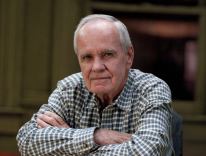The Spirit of Early Christian Thought:
Seeking the Face of God
Robert L. Wilken
Yale University Press, $29.95, 368 pp.
___________________________________________________
In the introductory pages of this fine book, Robert L. Wilken tells us that it is time to bid farewell to Adolf Von Harnack’s once influential thesis that Christianity, to its detriment, slowly became Hellenized by absorbing too much Greek thought. One still hears Harnack’s laments in critics’ complaints today about the classical formulations of Trinitarian or Christological doctrine. By contrast, Wilken argues that Christian thought developed from its intense and unwavering attention to the witness of the Bible. In that sense, Greek thought was Christianized and not vice versa.
That attention to the Word of God took several forms: steady meditation, performance of the Word in common worship, and works of evangelization and charity. Indeed, one must see the Bible in relation to the sacramental life of the church, to preaching, and to the defense of the faith. The ways in which the revealed Word was-and is-performed are quite varied, so it is gratifying that this book finds space to consider, among other things, the development of Christian poetry (in an excellent chapter on Prudentius) and the evolution of the icon.
Wilken knows better than most the mountain of secondary literature on the patristic period and the minefields of interpretation. His intention, however, is not to produce new scholarship (he already has an enviable track record of such production), but to write for the general reader. He has done so excellently, both because he knows the scholarship well and because he is blessed with a clear prose style. Thus, his explication of Trinitarian theology does not swan about in the world of abstraction but is studied vis-à-vis the liturgical faith of the church and the astounding witness of the resurrected Christ. Likewise, Wilken puts the development of the Christian moral life, not in terms of what he calls “spiritual athleticism,” but in the context of Christ who is both the goal and the finality of human life.
While this book is mainly concerned with the early church, it is not fundamentally a history. Wilken does not march us from the Apostolic fathers to the Council of Chalcedon and beyond, but uses evidence from all those periods. It is a synthetic work of historical theology that looks back to the past to insist on continuity with the present. The epilogue, for example, vigorously denies that the early reading of the Bible by the great fathers of the church is now a historical curiosity. It is, rather, the wellspring from which the later tradition would build and thicken. If the book has a lacuna, it is that Wilken does not deal extensively with the “rule of faith,” the summary of Christian belief used by the early church to distinguish orthodoxy from heresy.
This book would be excellent for classroom use. It is enhanced with some ten pages of recommended readings and an index of scriptural citations.
___________________________________________________
Early Christian Mystics:
The Divine Vision of the Spiritual Masters
Bernard McGinn and Patricia Ferris McGinn
Crossroad, $18.95, 256 pp.
___________________________________________________
For well over the past decade, Bernard McGinn has been producing a massive history of Christian mysticism in the West under the general title, “The Presence of God.” Three volumes have been published to date, taking us to the middle of the fourteenth century. This book, a collaborative effort by McGinn and his wife, may be thought of as a kind of “tasting menu” of the larger work. In twelve economical chapters subdivided into two parts (“Practices for Finding God” and “Transformation in God”), some of the major figures in early Western mysticism are presented.
Part 1 is arranged by topic: Origen on the spiritual reading of Scripture; Evagrius on ascetical practice; purity of heart in Cassian; compunction in Gregory the Great; vision and authority in Hildegard of Bingen; and the different modes of contemplation according to Richard of St. Victor. Part 2 takes up Gregory of Nyssa’s doctrine of epektasis (the endless yearning or straining toward God); Augustine’s mystical teaching; Dionysius on mystical theology; the self-manifestation of God in the cosmos according to John Scotus Erigena; and two chapters on the great Cistercian fathers: Bernard of Clairvaux and William of St. Thierry.
Each chapter runs about twenty pages and typically includes a biographical sketch and a brief survey of the main themes of the subject’s “doctrine.” That means, of course, that the McGinns cannot do much more than provide a succinct overview. In one sense, this book makes a nice follow-up to Wilken because the McGinns tell us how a select number of Christian thinkers extended the Christian search for “the face of God.” The most valuable contribution of this book may be to spur readers to explore these writers in greater depth. I would recommend the volume especially to those interested in Christian spirituality. It is simplistic to study, for instance, the Ignatian Spiritual Exercises or any number of other solid forms of Christian spirituality without knowing that they have deep roots in an earlier period.
___________________________________________________
Teresa of Avila: The Way of Prayer
Edited by Kieran Kavanaugh
New City, $13.95, 159 pp.
___________________________________________________
Kieran Kavanaugh’s new volume on Teresa of Avila is part of a series published by New City Press. Each volume has a long introduction and a collection of primary texts. Kavanaugh, of course, is the translator of all of St. Teresa’s writings and a leading scholar of Carmelite mysticism.
Teresa wrote a number of important works: her autobiography in 1565; the Way of Perfection (1567); The Interior Castle (1577); and The Foundations, finished in 1582, the year of her death. The first three books treat her doctrine of prayer in detail but, as readers well know, her vocabulary changes. Her classifications of the stages of prayer are not constant and she frequently digresses. Reading Teresa whole can be a challenge if one is not accustomed to her sprawling style. Kavanaugh has organized the fundamental texts on prayer in chronological order to illustrate the main trajectory of her doctrine. His crisply written introduction is an invaluable aid to making sense of the texts. His section on Teresa’s use of Scripture features selections from her little-studied meditations on the Song of Songs.
To my chagrin, I picked up this volume after teaching The Interior Castle in a course on the theology of prayer. Had I known about it earlier, I would have saved myself much time going back to the Life and the Way of Perfection to sort out some of Teresa’s references and classifications. Anyone who wishes to encounter this great spiritual mistress of prayer would do well to begin with this little book.
Although Teresa often tells us that she lacks the proper words to say what is in her heart or that she is obliged to learn from learned men, the fact is that she was a great teacher of prayer and is rightfully enrolled among the doctors of the church. The more I read her the more I learn. To read her intelligently, however, requires some tolerance for an unusual use of language and metaphor. Kavanaugh is a sure guide and, along with his exemplary translations, we now have this tidy little book to help us reach up to this great soul.
___________________________________________________
God’s Secretaries: The Making of the King James Bible
Adam Nicolson
HarperCollins, $24.95, 281 pp.
_____________________________________________________
The King James Version of the Bible-known as the Authorized Version in the British Isles-is, to use the old quip, the only masterpiece produced by a committee. That committee consisted of over fifty-odd scholars divided into six groups who labored from 1607 until the large folios were printed and circulated in 1611. Their translation drew upon the earlier work of William Tyndale, who went to the stake for his efforts; the so-called Bishops’ Bible, which had been done in the middle of the sixteenth century; the (Roman Catholic) Reims New Testament; and the Calvinist-inspired Geneva Bible.
It was a miracle that the work ever came to a happy end. The ideology of the translators varied greatly, from Puritans to high-church Anglicans. James himself had hoped the new Bible would help bind together a nation torn by religious conflict. He certainly wanted an alternative to the Geneva Bible with its antimonarchical touches, such as its penchant for translating the word “king” as “tyrant.” The translators faced other difficulties. Were they to try for the linguistic tone that captured ordinary speech (Luther’s approach in his translation in German) or were they to strive for the exactitude demanded by the Calvinists, whose views on the Word of God were stringent? How were they to solve the vexatious issues about church orders in the pastoral epistles of Paul when that was the precise place where Presbyterian and Episcopal ecclesiology was at loggerheads?
Nicolson tracks these issues with a sure narrative sense and a wonderful sensitivity to the culture of Jacobean England. He is particularly good at providing biographical profiles of some of the major players. Central to the work of the translators was the staggeringly learned Lancelot Andrewes. A devout high churchman whose morning devotionals were four hours long (centuries later John Henry Newman prayed from his preces privatae and translated them into English), Andrewes was also a keen collector of benefices to support his life style and a merciless antagonist to those who did not share his theological opinions.
Some have argued that the translators of the Authorized Version cribbed much from Tyndale. Indeed, more than 90 percent of the Authorized Version is identical to the Tyndale translation. But it is the small portion that is new that is critical. Nicolson argues that it is this part that makes the Authorized Version so masterful, giving it “immediacy, dignity, a sense of deep, musical rhythm, an intuitive and poetic understanding of the connection between the present and the past, a tangible empathy, a precision, ‘an ordonnance’ to use [T. S.] Eliot’s word, a careful elaboration of arrangement and structure.”
The Authorized Version did not become England’s official Bible until after the Restoration in 1660, when it came to represent the old order of monarchy before the revolution of 1648. Lancelot Andrewes quoted from the Geneva Bible as did the preface to the first edition of the King James Bible. The Puritans brought the Geneva Bible with them on the Mayflower, although the King James Bible eventually became the Bible of Protestant America. Nicolson notes the irony: “It is one of the strangest of historical paradoxes that the King James Bible, whose whole purpose had been nation building in the service of a ceremonial and Episcopal state church, should become the guiding text of Puritan America.” end
Please email comments to [email protected] and join the conversation on our Facebook page.
Share
Previous Story
Learning curve
Next Story
Sex, Women & The Church


